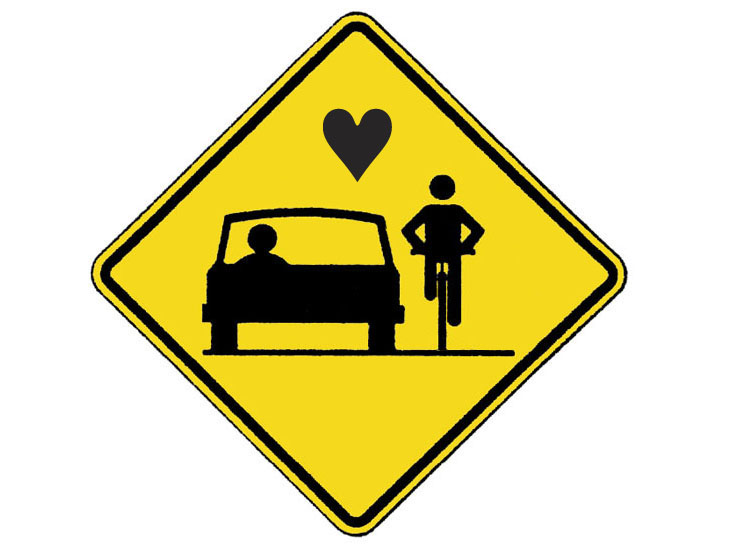Good Fences
 Share the Road – a popular phrase bandied about by cycling advocates, commuters and bike lovers everywhere. While it is used with the best possible intentions, these three little words form a statement that is (in my humble opinion) misleading, vague and quite possibly even dangerous. I’m no scientist, but isn’t the fact that cars and bikes mingle badly on roads the reason we have car-bike collisions? “Sharing the road” is not the solution. It is the problem.
Share the Road – a popular phrase bandied about by cycling advocates, commuters and bike lovers everywhere. While it is used with the best possible intentions, these three little words form a statement that is (in my humble opinion) misleading, vague and quite possibly even dangerous. I’m no scientist, but isn’t the fact that cars and bikes mingle badly on roads the reason we have car-bike collisions? “Sharing the road” is not the solution. It is the problem.
Yes people, cover your children’s ears. In spite of what the nice man in the white van with tinted windows told us, not all sharing is good sharing.
I understand why the phrase is so popular. Sharing, after all, is such a happy and positive word. We share cookies, our feelings, and in the case of that one special someone, our beds (except for that unfortunate incident in Mazatlan, but I digress). The road is not for sharing. And certainly not with unprotected strangers.
“Share the road” provokes and encourages unwanted closeness and can lead to bad touching. Sometimes it is unintentional, like a gentle nudge into a ditch or parked car. Or perhaps the sweet caress of a door as it breaks your face. Sometimes, it is intentional – like the impatient driver who forces violent rear-end intrusions by tailgating their unwilling cycling victims. Thank you sir or madam, I do not care to be ass-fucked by your SUV.
Sharing also implies a ridiculous and dangerous notion of equality. Cars and cyclists are not equal – not in size, speed, or quantity. Cars typically do not bleed or die when hit by a cyclist. And cars generally like to be on top.
Nobody, neither cyclists nor drivers, really knows what “Share the Road” means. Share it how? Cyclists assume the message is directed to drivers, drivers assume the opposite. So we stare each other down, wave our fists, and engage in passionate debates (“Fuck You NO Fuck YOU!”), each with our own supercilious feelings of road entitlement. And sometimes, we touch. Bad touch.
So what else, if not “Share the Road”, do we use to tell people what to do? How about something straight to the point like “Back off”. Too harsh? How about “Don’t touch me, I have a headache”.
The “One Meter Please” campaign is getting closer to a clear direction. It is polite request for drivers to leave one meter between their car and cyclists on the road. This assumes the general population knows how big a meter is, and how to approximate that distance from inside the sanctity of a large moving metal box. If we’re asking for a meter, why not ask for a whole lane? If we are at that point in our relationship where we are sharing stuff, why be shy about it? The point is, we need to leave lots of space between us. If there is space, there is less likelihood of any bad touchy-touchy.
When I was a kid my Dad often said “Good fences make good neighbours”. I took it pretty literally, since Dad never really liked the neighbours. But of course the meaning is figurative. A little bit of space and mutual understanding between people can make for a much more tolerable relationship, and dramatically decreases the likelihood of neighbours killing each other.
The reality is, I don’t think it’s just a catchy slogan we need – it’s not going to be that easy. We need to build those figurative fences with better infrastructure, education, and a commitment to make road sharing a safe and pleasant activity for everyone. Thankfully there are people way smarter than me who have figured out how to do that. People in places like Copenhagen, Montreal, Sydney and Minneapolis. All bike-friendly places that have integrated biking into their transportation culture, and are all the richer for doing so. We could learn a lot from them.
I’ll share my cookie, my feelings, and, apparently, after 14 tequila shots, even my bed. But share the road? Let me think about that.

Ha ha! Great stuff. I love the sign….maybe we should make it into a licence plate?
Fantastic, as usual. Thanks Andrea.
Great post Andrea! I really enjoyed reading this and feel the same way!
You, are my favorite facebookian. Love the double entendreas. Tequila shots sometime?
Love your debating!!
Brilliant writing, Andrea! Well done. 🙂
Thanks for the love everyone. I’d do tequila shots with all of you.
WCC is the best!
Well written. Excellent posts. Keep them coming.
I like the option of a separate bicycle infrastructure with citywide paths. However, what I realize when I ride the paths now available is that I get so impatient with slower cyclists (and embarrassed by constantly ringing my bell) that I opt for the shoulder of the road anyways. Since cycle paths with multiple fast and slow lanes would be nothing but a utopian dream in Manitoba, I fear us roadie enthusiasts will have to face a future of “share the road” (or slow down and smell the flowers – not likely for the riders I know).
Cycling and running on the road is much safer than being on the sidewalk. I also get frustrated wtih slower cyclists on bike only pathways. I commute everyday by bike and find drivers considerate of my bike even on Portage Av. I think on Portage they have diamond lanes for bikes and buses. New roads have room for bikes with painted lanes. ie Provencher bridge. I see more vehicles honking at each other than at bikes.
Love your posts. We have a tequila collection at home just sayin. 🙂
Great post I’m glad I found your blog you are a good writer
A perspective from another country . As an Australian living in smaller provisional city (200,000 ) in North Queensland your post was timely and important as I have been recently observing how cars interact with cyclists when I am out cycling and when I’m driving how I and other motorists manage cyclists on the road.
Apart from taxi’s which have driving rules of their own I think we do it pretty well and I guess we are helped by having most of our roads marked with a decent bike lane which helps set a boundry of what a cyclist can safely ride in and what a vehicle should not drive in.
I would like to see increased road signage reminding the driver of his/her responsibilities to the cyclist but while there is a few of these out there they are in the minority.
So a great post pity it wasn’t seen by more —relevant to all cyclists in all countries
Thank you Ian! Great to hear from someone in a different country, and in a city that is making it work. As a commuter, I love the painted bike lanes and bike paths. But you’re right, more signage and education are critical. Twice I have been in a separated buffered bike lane (with a curb) and had cars come straight at me, in the bike lane. Just folks who didn’t understand they weren’t supposed to drive there.
RJ and Ed make good points too – we have to be careful what we wish for. As an avid road cyclists, I often ride at high speeds and often in a large group. There is no way we can ride that way in bike lanes or shared paths.
The more bikes there are on the road (and research shows it is growing rapidly here) the more drivers become accustomed to “sharing the road” with both commuters and “sport” riders. But there is as much education required for cyclists as well, some of whom are guilty of atrocious road behavior.
Sorry just deleted a whole long rant.
Keep up great thought provoking and entertaining posts Andrea. 🙂
Wonderful post. I would like to put up a link to this once I have my website set-up, is that alright?
(My website’s not for the public cycling community; mainly for a few buddies that cycle around my neighbourhood!)
In reference to the 1m rule though, I always thought 1m from the kerb was the unwritten “safe” distance. However, I do like the idea of a standard 1m distance from motorists. 🙂
Hi Tim
By all means, please feel free to put up a link! The more readers the better. And yes, drivers should stay 1 meter away from cyclists, rather than the curb. In some places (mostly in the US) it’s the law. We (cyclists) should stay a good distance from the curb, parked cars, etc. to stay safe as well.
Thanks for the visit and the feedback! Cheers!